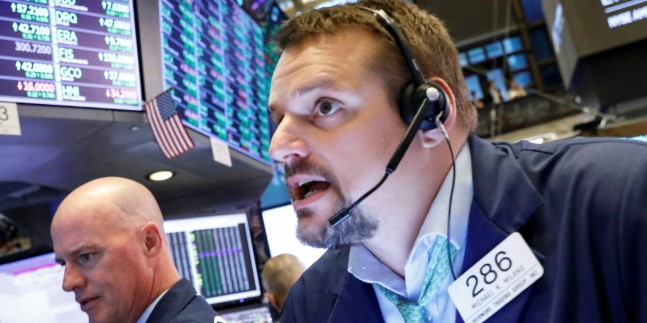
Stocks ended Thursday’s session little changed as investors digested strong employment data while they monitored the latest news from the U.S.-China trade negotiations.
The Dow Jones Industrial Average gained just 28.01 points, or 0.1% to close at 27,677.79. The S&P 500 advanced 0.16% to 3,117.43 while the Nasdaq Composite gained less than 0.1% to close at 8,570.70. The major averages oscillated between slight gains and losses throughout the day as they struggled to find direction.
Nike led the slight gains for the Dow, rising 2.2% after a Goldman Sachs analyst upgraded the stock. Apple also rose more than 1%. Communications services and tech rose 0.4% each to drive the S&P 500 marginally higher.
“On balance, U.S. equities appear to be in pause mode and for good reason,” said Terry Sandven, chief equity strategist at U.S. Bank Wealth Management. “Performance this year has been superb, balanced and broad based.”
“Our preference is for the equity market to trend sideways into the end of the year, but I suspect there will be some volatility,” Sandven said.
U.S. weekly jobless claims dropped 203,000 last week, the Labor Department said. That’s below a Reuters estimate of 215,000. The print was the lowest in seven months. The report quelled fears stemming from a disappointing private payrolls number released Wednesday. It also comes a day before the government’s monthly nonfarm payrolls report.
Thursday’s choppy moves came after the market experienced strong swings to start December that were sparked by mixed news on trade.
On Wednesday, the Dow gained nearly 150 points after Bloomberg News reported Wednesday, citing sources, that both countries were inching closer to securing an agreement on the amount of tariffs that would be rolled back in a limited trade deal. President Donald Trump also said Wednesday that he believed trade talks with Beijing were going “very well.”
The report, along with Trump’s comment, lifted sentiment around trade and helped the major averages snap a three-day losing streak. That slide came after Trump said Tuesday he could wait until after the 2020 election to make a deal with China and after the Chinese said they wanted tariffs removed as part of a phase one trade deal.
“The last few days have made it clear this is still a market focused on the prospect for some resolution to the trade war with China,” said Willie Delwiche, investment strategist at Baird. “Any hopes that we were moving beyond that seem to be dashed.”
China and the U.S. have 10 days to reach a trade deal before additional U.S. tariffs on Chinese goods take effect. Those levies would target an additional $156 billion in Chinese goods.
“Unless there’s deal announced in the next week and half, or the U.S. unilaterally decides to delay or cancel the next scheduled set of tariffs, we’re going to have more of these kicking in,” said Brian Nick, chief investment strategist at Nuveen. “That’s not at all priced into the market.”
“In fact, expectations that those tariffs will be removed along with the October ones has been one of the reasons we’ve been able to melt up so quickly,” Nick said.
Trump said Thursday that something could happen regarding those tariffs, but added they are not discussing that yet. He also reiterated that trade talks between the two countries were going well.
Chinese Commerce Ministry spokesman Gao Feng said Thursday the two sides remain in close communications regarding trade. Gao did not, however, give any details on how the negotiations were proceeding. He added that China “believes if both sides reach a phase-one agreement, relevant tariffs must be lowered.”
The U.S. and China have imposed tariffs on billions of dollars’ worth of one another’s goods since the start of 2018, battering financial markets and souring business and consumer sentiment.
The U.S. trade deficit tumbled to 7.6% to $47.2 billion in October, a 1½-year low as imports dropped by $4.3 billion.






















![PS4 Experiencing Issues As PSN Is Partially Down [Update: Back Online]](https://flyonwallstreet.com/wp-content/uploads/2018/01/ps4-pro-pre-order-imageblock-us-07sep16.png)

